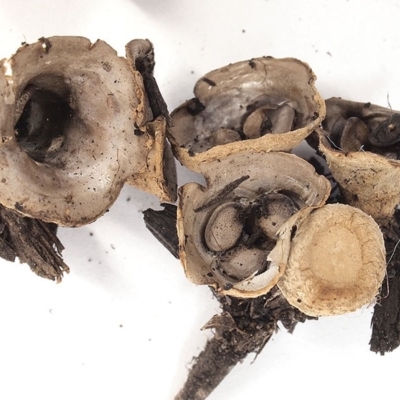Cyathus olla
This is one of the Birds Nest Fungi. The fruit body resembles a cone, with the narrow end attached to the substrate. It may be buff, grey-brown, greyish and up to 15 millimetres tall. Within the cone are a number of disk-like ‘eggs’ (technically peridioles). Initially the broad top is covered by a membrane (or epiphragm) but at maturity this breaks down to reveal the eggs. The outer surface of the cone (and the epiphragm) may appear almost smooth but a closer look will usually reveal a covering of fine, matted hairs. The mouth of the cone is greatly expanded or flared (and the margin, which may be wavy, may even curve further and fold downward slightly). This is best seen when fruit bodies are not densely packed. The inner surface of the fruit body is smooth (though at times with some weak ridging around the wall, horizontally not vertically).
The peridoles are large (up to 3.5 mm in diameter) and each is attached to the inner surface of the fruit body by a cord.
This cosmopolitan species is found on soil, woody debris or dead plant stems.
Look-alikes
A flared mouth, smooth inner surface and smoothish outer surface should make this species distinctive. Other Birds nest Fungi differ by showing one or more of the following features: shaggy outer surface and epiphragm (if present in a species); vertically striate inside (or outside); mouth not flared; peridioles less than 2.5 mm in diameter; peridioles with no attachment cord.
Cyathus olla is listed in the following regions:
Canberra & Southern Tablelands
Species information
- Cyathus olla Scientific name
- Common name
- Not Sensitive
- Cosmopolitan
- Non-invasive or negligible
- 130.8m to 607.1m Recorded at altitude
- Machine learning












